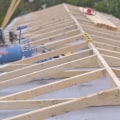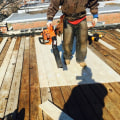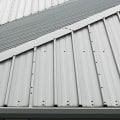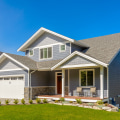Flat roofs are a popular choice for many homeowners and builders, but they come with their own set of advantages and disadvantages. The biggest disadvantage of flat roofs is drainage or lack of it. Sure, flat roofs have a slight slope that drains water, but not as efficiently as a sloped roof. Rainwater tends to stay on the roof and form a puddle, which can cause potential leaks or material damage.
The same applies to the repair of a flat roof system. Patches are available for different flat roof systems, so they take less time to repair. If an asphalt shingle needs to be repaired, for example, if a tree branch punctured it, it is often necessary to repair surrounding shingles as well. You see, asphalt shingles are layered: half of one shingle is under the other, so there are always at least 2 layers of asphalt shingles anywhere on the roof.
In addition to drainage issues, some people think that flat ceilings are less elegant. Flat roofs tend to be less stable, especially large flat roofs. The larger the flat roof, the less stable it is. To compensate, additional structural stability must be incorporated into other areas of the building.
Because there is no sloped roof and therefore no attic, there is less insulation space. Insulation is basically an empty space between the undesirable space (the outside) and the desirable space (the inside). With a sloped roof, that insulation is your attic. With a flat roof, there is much less insulation.
As a result, your home or building could be affected by extremely fluctuating temperatures. Another disadvantage of flat roofs is that they require more maintenance than sloped roofs. Drainage, or rather, the lack of it, is the biggest disadvantage. Flat roofs don't drain as efficiently as sloped roofs.
Water tends to accumulate and stay on the roof. Stagnant water can cause roofing material to break or future leaks, especially along the seams. A flat roof contractor is likely to install additional mechanisms to address proper drainage. Water disposal options are time consuming and can be costly.
You'll probably need to pay more attention to a flat roof because of potential drainage issues. With a flat roof, you can anticipate the formation of puddles after a few days of rain if the roof itself is not planned or installed properly. One of its main drawbacks is that it is not environmentally friendly. Flat roofs work best in arid climates.
Therefore, places with frequent rains or snow can accumulate due to the poor drainage system that is often associated with flat roofs. This could eventually lead to leaks or cracks in the roof if proper precautions are not taken. A major disadvantage of a flat roof over an inclined roof is that its stability decreases as its size increases. A very large flat roof usually cannot prevent flooding after a period of heavy rain, and there is a greater risk of collapse due to the weight of this water.
To avoid flooding problems, the synthetic rubber coating that has been applied to the roof surface must be checked periodically. Proper maintenance is also essential to prevent roof leaks. The high potential for a flat roof to leak often causes insurance companies to charge high insurance premiums.
Advantages of Flat Roofs
Despite all these drawbacks, there are still some advantages associated with flat roofs that make them attractive for certain applications and locations.Buildings with flat roofs are more affected by extreme temperature changes because there is less space for installation. The absence of slanted overhangs on flat roofs allows better access to more natural light in your home. The search for flat roof materials generally depends on the type of material you choose and its availability in your location. A flat roof is one of the ways you can create more space (especially outdoors) to achieve your dream home.
Flat and pitched roofs have their advantages and disadvantages, so consider your options and the long-term costs of both. We briefly addressed this advantage in a previous blog post about the reasons why most buildings have flat roofs. If you answered yes to any of these questions, you must have the right information about flat roofs so you can make the right choice. We have also installed many flat roof systems in residential structures, such as house extensions and detached garages.
Installing these energy-saving and environmentally friendly solutions on a flat roof allows you to get the most out of them. Every buyer and homebuilder has a vision for their dream home, and a flat roof could be the perfect choice for you. Maintenance requires flat roof repair contractors to address shrinkage caused by prolonged exposure to UV rays. Now that you know the common advantages and disadvantages of flat roofs, it's time to look at some options.



